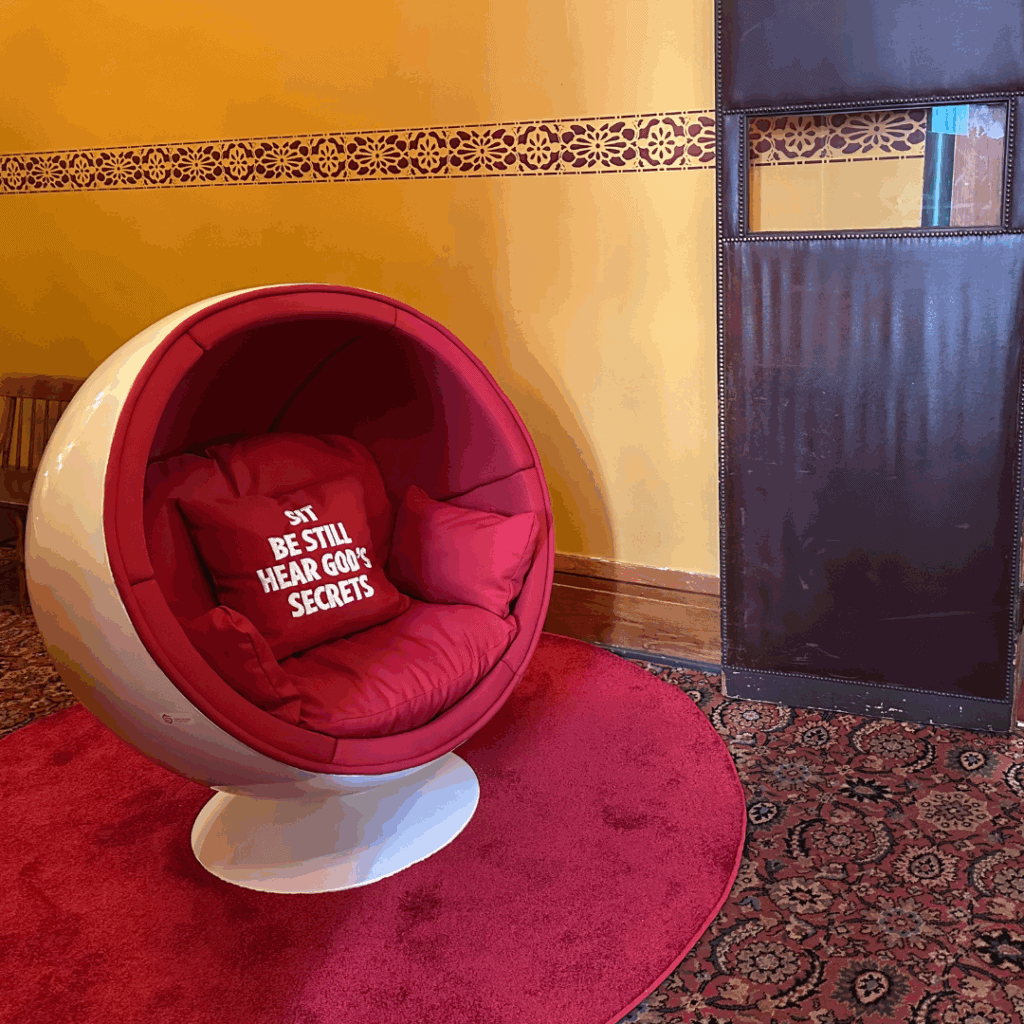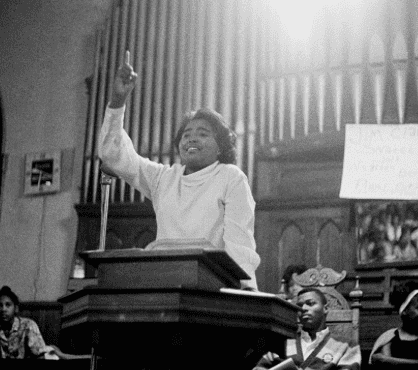God's Secrets: An Immersive Art Experience
Imagine stepping through a hidden door into history’s back room — to overhear fervent prayers of unsung saints, listen to conversations that shaped dreams of freedom for generations, and bear witness to quiet acts of dignity that fueled that movement.
God’s Secrets is an immersive art experience that invites people to encounter the stories of Christian freedom fighters that have often been overlooked.
Designed by acclaimed multi-disciplinary artist Shabazz Larkin and narrated by renowned historian Dr. Jemar Tisby, this traveling chair invites visitors to sit, be still, and hear untold gospel hope stories — featuring lesser-known Black Christian leaders whose faith fueled movements for justice. Three audio stories describe the contributions of Anna Murray Douglass, Prathia Hall, and The Savannah Colloquy.
God’s Secrets is a traveling exhibit available to churches and organizations that want to make available the remarkable stories of courage and hope that undergird the work of God in often unseen places. Each of the three audio stories is about eight minutes in length. The entire experience is 25 minutes in length.
God’s Secrets is a story of the Storytellers Collective, a multi-year, national storytelling initiative that is amplifying stories that challenge despair and stir the Church’s imagination for a more just, faithful future.


There is no book big enough to hold all of God’s stories.
Imagine if no one had written down the life of Abraham or David, or the words of James, the brother of Jesus.
Imagine if the journeys of Paul the apostle, Martin Luther, or Francis of Assisi had never been told.
The truth is, much of God’s greatest work happens in secret — in the quiet, hidden, and unseen.
Until someone chooses to tell the story.
Sit. Be Still. Hear God’s Secrets.
Below you will find the three stories featured in God’s Secrets. If you are unable to visit the chair in person, we encourage you to listen to the audio versions on this page and share them with others.

Anna Murray Douglass: The Woman Who Made Escape Possible
Anna Murray Douglass was the quiet but indispensable partner behind Frederick Douglass’s journey to freedom. A free Black woman who sewed his disguise, financed his escape, and sheltered him afterward, Anna later managed their home and supported the Underground Railroad while raising five children. Her legacy is a testament to the hidden labor and spiritual strength of Black women whose contributions to liberation too often go unrecognized.

Prathia Hall: The Woman Behind the Dream
Prathia Hall was a pioneering civil rights leader, preacher, and one of the first Black women ordained in the American Baptist Church. Her powerful prayer at a 1962 vigil for burned Black churches inspired the phrase “I have a dream,” later echoed by Dr. Martin Luther King Jr. Hall’s life embodied what she called freedom faith — the conviction that God desires all people to be free and equips them to fight for that freedom.

The Savannah Colloquy and Special Field Order No. 15: The Promise of “40 Acres and a Mule”
This story traces the origins of the promise of “forty acres and a mule” to a meeting of twenty Black ministers with Union generals in 1865. Led by Garrison Frazier, they called not for charity but for land and autonomy — the foundation for true freedom. Though President Andrew Johnson rescinded the order, their vision seeded generations of Black resilience, faith, and the ongoing pursuit of reparations and justice.
God's Secret's Designer & Narrator:

Shabazz Larkin, Chair Artist and Designer
Shabazz Larkin is a Nashville-based, acclaimed, multidisciplinary artist, illustrator, and creative director whose work weaves together themes of race, spirituality, and Black culture in vibrant visual form. With a background in both fine art and advertising, his creative practice bridges visual storytelling and social commentary, inviting audiences to see the sacred in the everyday. Shabazz’s art often centers forgotten or overlooked narratives, using color, texture, and sound to awaken empathy and curiosity. He is the designer of God’s Secret Chair, a living installation created to help people sit, listen, and encounter hidden histories anew.

Dr. Jemar Tisby, Chair Narrator
Jemar Tisby is a historian, author, and public theologian whose work explores race, religion, and social justice from a Christian perspective. He is the author of the New York Times bestseller "The Color of Compromise" and "How to Fight Racism," and he hosts the award-winning "Footnotes with Jemar Tisby" podcast. A graduate of the University of Notre Dame and the University of Mississippi, Jemar holds a PhD in History from the University of Mississippi. As narrator for God’s Secret Chair, he brings his deep knowledge of faith and history to amplify the voices and stories too long left unheard.
Read the Artist's Statement
Shabazz Larkin Artist Statement
I designed God’s Secrets to feel like a place where secrets are whispered — a quiet invitation to be still and listen. As an artist, I’m drawn to the mystery of the unrecorded moment, to reimagining what was said in rooms where no one pressed “record.” The chair becomes a vessel for that sacred work — the work of reaching into the unknown and making it known, of hearing what was once unhearable.
The stories woven into this chair are everyday acts of faith and love from people history has too often forgotten. Their lives may be adjacent to the stories we know, but they pulse with truth and courage. These are the stories that make our collective memory whole.
In a world that moves at light speed, this chair asks us to slow down. To sit. To listen. The story of Anna Marie Douglas, whose single recorded sentence became a meditation for this piece —“Why not we endure hardship so that our people might be free” — is an invitation to enter into sacred endurance and communal hope.
When asked to tell the stories of forgotten heroes, imagination must join the conversation. In the reimagined prayer meeting where Prathia Hall first spoke the words that would inspire “I have a dream,” we are reminded that small, unseen acts can ripple through history. This chair is both altar and amplifier — a place where art, memory, and faith meet to remind us that nothing sacred is ever truly lost.
Note on the Use of AI
Note on the Use of AI
Some voices have been lost to time.
To honor their stories, a few portions of this audio experience use AI-assisted voice recreation inspired by written and historical accounts. These dramatizations are creative interpretations — not actual recordings — crafted to help us imagine and remember the voices that once carried these truths.
